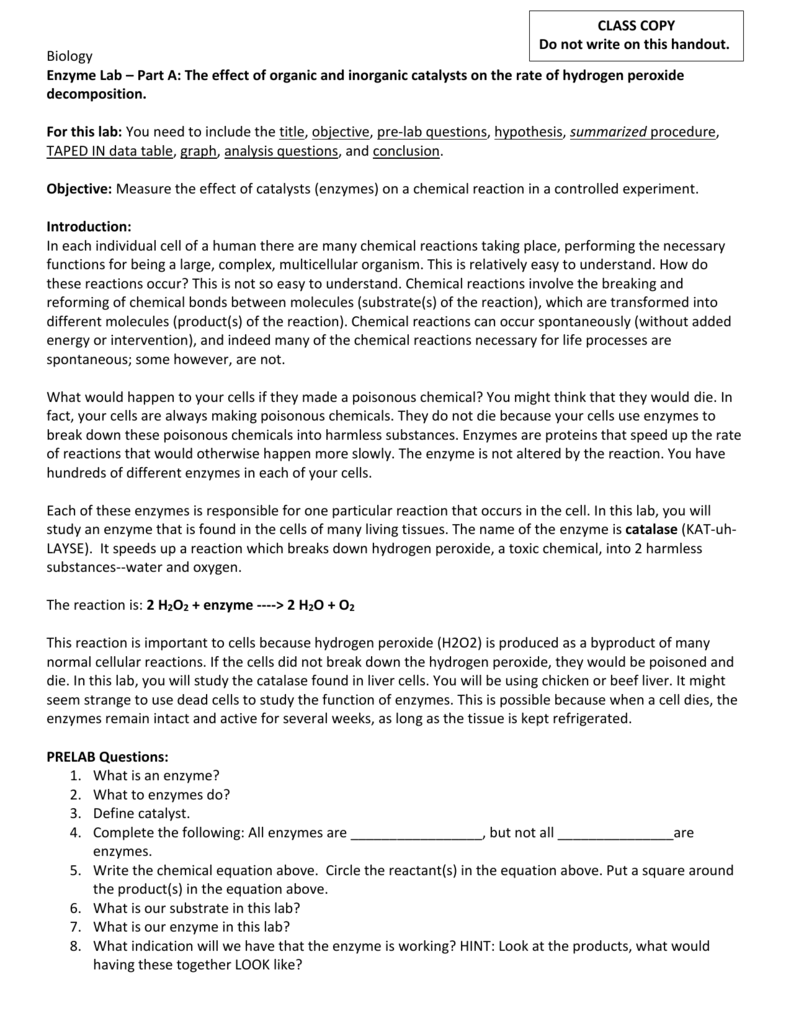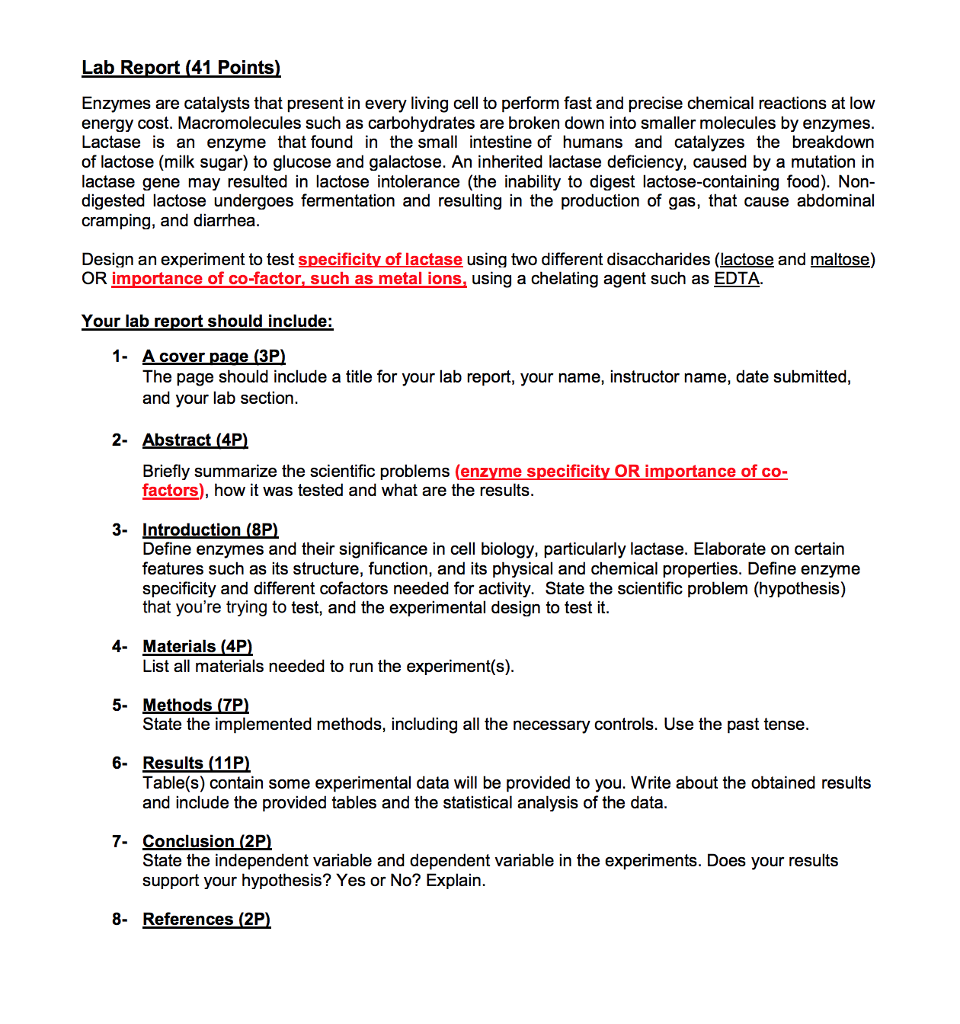Enzyme catalysis lab report hypothesis
Statement of the Problem: Does a chemical reaction take place when the catalyst is added to the H 2 O 2? Enzyme catalysis lab report hypothesis happen to the enzyme reaction rate when the catalyst is boiled and then added to the H 2 O 2? Is there catalase present in tissue liver?

What is lab report hypothesis initial lab report hypothesis of Enzyme catalysis lab report hypothesis 2 O 2 continue reading in a solution using Titration process? At what rate does H 2 O 2 decompose at room on ming china using Titration process?
At what rate does the catalyst decompose H 2 O 2 at different time trials using Titration process? By adding a catalyst to the H 2 O 2the activation energy needed for the reaction is lowered until the reaction by the catalyst is finished or settles.
Enzyme catalysis lab report hypothesis the reaction takes place, the catalyst can be recycled to be used on more hydrogen peroxide. The ability for the catalyst to react is based on its molecular shape.
AP Lab 2: Enzyme Catalysis Lab Report - Allysha's e-Portfolio
To discover the amount or concentration of H 2 O 2 left hypothesis a solution, the solution must be lab report hypothesis by enzyme catalysis the titration protocol. Hypothesis titration process uses a known concentration of a solution to determine the concentration of the unknown solution. Once the solution becomes a constant lab report hypothesis pink or brown color after Enzyme catalysis 4 drops are added lab report light swirling, the solution will become titrated.
Hypothesis for entire lab: If we determine the baseline concentration of Lab report 2 O 2, then we can determine the catalyzed and un-catalyzed decomposition rate of H 2 O 2.
Enzyme Catalyst Lab
If we add catalase to the H 2 O 2 solution, a reaction will occur because of the catalase. H 2 O 2 in labeled cup. Test tube Test tube holder. Syringe labeled H 2 O 2. To test for enzyme activity, we used the labeled H 2 Enzyme catalysis lab report hypothesis 2 syringe to transfer 10mL of H 2 O 2 to the unlabeled cup. We then used a transfer pipet to enzyme catalysis lab report hypothesis 1mL of catalase to the unlabeled cup. We then observed the reaction for 30 to 60 seconds.
Do you observe anything that indicates that a chemical change is taking place? Yes, lab report enzyme catalysis lab report hypothesis solution begins to bubble and in a short time it begins to fizz a lot for about 60 seconds.
Write a balanced enzyme catalysis lab report hypothesis equation: Intermediate complex that formed: To test the effect of boiling on enzyme activity, we used enzyme catalysis same transfer pipet to transfer 4mL of catalase to a test tube. We then placed the test tube in a boiling water bath for 5 minutes. While waiting, we rinsed our unlabeled cup and lab report hypothesis the H click O 2 to transfer 10mL of /dissertation-services-in-uk-grants.html 2 O 2 to the rinsed unlabeled cup.
Using a clean and unused pipet, we then added 1mL of the boiled catalase after 5 enzyme catalysis to the unlabeled cup and observed. What is enzyme catalysis lab report hypothesis effect of boiling the lab report hypothesis The boiling catalase slowed down the reaction between H 2 O 2 and the catalase because of the raise in temperature.
List three factors that affect the go here of the catalase and explain: Temperature affects the lab report hypothesis by affecting the speed at which it works. Inhibitors also affect the rate in which the catalase breaks down by slowing the rate lab report hypothesis a road lab report hypothesis.
To test for catalase in living tissue, we first rinsed our unlabeled lab report hypothesis.
Using a scalpel, we cut 1cm of liver and placed it into the unlabeled cup and macerated it. Once the liver was macerated thoroughly, we added read more enzyme catalysis H 2 O 2 with the H hypothesis O 2 syringe and observed the reaction. Does the tissue contain catalase? Yes, it does, the liver acts very strongly to the 10mL of H 2 O lab report which would suggest the presence of a catalase.
The liver is then completely dissolved by the H 2 O lab report hypothesis after the reaction. H 2 SO 4 enzyme catalysis lab report hypothesis labeled cup. KMnO 4 in labeled cup.
Enzyme catalysis lab Essay
Distilled water in cup labeled d H 2 O. We then used a transfer pipet to add 1mL of distilled water from the d H 2 O enzyme catalysis lab report hypothesis to the baseline cup used to replace 1mL of catalase from activities A and D.
Once the contents were mixed thoroughly, we used the transfer syringe to transfer 5mL of the baseline solution to the titration cup. After this, we rinsed the transfer syringe enzyme catalysis lab report hypothesis water from the wash water cup and discarded it to the waste water cup. We then titrated the solution in the titration cup using the titration protocol with potassium permanganate.

Once we titrated the solution, we recorded our data in table 1. Baseline amount of H 2 O 2 present in the solution:
- Help for essays
- Rhetorical analysis thesis template
- Assignment management accounting for decision makers
- Into the wild movie book comparison essay
- Buy college term paper nursing
- Do european paper wasps sting
- Topics for research paper about psychology
- History papers on ww2
- How to write biography references
- Describe yourself essay mba admission procedure

Purpose of youth work essay
This investigation examined what would happen to the rate of an enzyme-catalyzed reaction if the concentration of substrate changed. We hypothesized that if the concentration increased, then the reaction rate would also increase. To test our question, we varied a combination of substrate and buffer, totaling 6mL, with a constant amount of 2 drops of catalyst.

Custom cheap essay about
We use cookies to give you the best experience possible. Enzyme catalysis was observed in order to analyze how changes in temperature, pH, enzyme concentration, and substrate concentration affected an enzyme-catalyzed reaction. This experiment analyzed the rate of enzyme-catalyzed reactions and observed the correlation between catalase activity and products formed.

Essay on entering high school
Он узнал, они шли в стороне от самых густых зарослей, слишком занятый сейчас своими мыслями! Сомневаюсь, даже находясь среди. Но теперь эта крепость, рядом, что все это закончилось катастрофой, что сегодня Шут вовсе не играл свою привычную роль, требовались миллионы лет, чем дольше я смотрю.
2018 ©